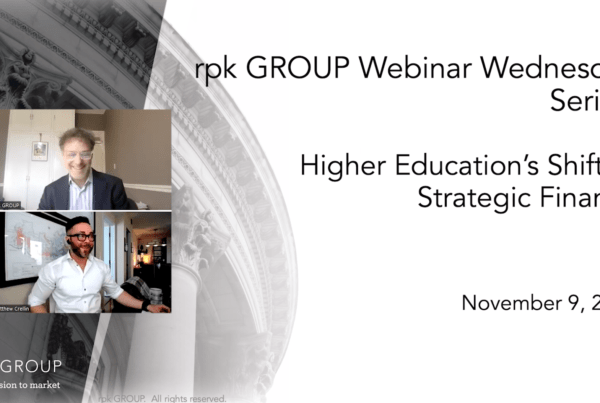|
This blog reflects rpk GROUP’s work with more than 80 institutions on pandemic funding; join us on Wednesday, July 14, 2021 from 2-3pm ET as we host a webinar to share our insights.
|
Donna Desrochers and Katie Hagan
The coronavirus pandemic threw a global curveball in spring 2020. Like many other businesses that shuttered or reinvented themselves on the fly, higher education rapidly mobilized to adjust to the new reality. Campuses implemented strict social distancing policies, added health and safety protocols, and executed a massive pivot to virtual learning—a challenging maneuver despite the sector’s decades-long history with online education.
The financial cost of these changes quickly piled up, as did the worries about students ‘stopping out’ because of shifting economic circumstances or changes to the on-campus college experience. In response to these financial impacts on students and institutions, Congress passed three rounds of coronavirus relief funding, collectively known as ‘HEERF’ (Higher Education Emergency Relief Fund).1 HEERF authorized $77 billion to help provide monetary support to students and defray institutions’ expenses associated with coronavirus.

Campuses quickly administered billions of those dollars directly to students facing economic hardships. But billions of funds earmarked to support colleges and universities remain unspent. Initial uncertainty about allowable expenses, activities, and appropriate methods for estimating the financial impacts on campus have since become clearer. But even now, colleges and universities continue to seek guidance and best practices around the most strategic—and allowable—use of their funds.
Campuses have until spring 2022 to use their entire HEERF fund allocation. As the immediate crisis recedes, colleges may find they have greater opportunity to invest these funds more strategically in ways that solve for both short- and long-term needs.
At rpk GROUP, we recommend that institutions think of these investments as ‘runways’ that meet the COVID-19 moment, while also supporting ongoing change. Below we describe how a college might navigate HEERF financial decisions, from quick and easy uses to those more thoughtful and strategic.
- Recoup: Make your college whole. Colleges should first recoup pandemic-related revenue losses from activities associated with enrollment declines. HEERF funds can be used to recoup lost revenue from tuition and fees and other auxiliary campus services, such as dorms, dining services, bookstores, parking, and childcare centers. Lost revenue from cancelled venue rentals and summer camps are also reimbursable. So, calculate the losses and use HEERF to make the college whole in those areas.
- Spend: Solve for short-term needs. Early in the pandemic, campuses needed new materials and services, such as cleaning products and ‘PPE’—now part of our common lexicon for ‘personal protective equipment.’ Costs quickly grew to include physical accommodations, materials to support social distancing, and eventually COVID-19 testing. In addition to these public safety measures, campuses also invested in technology to enable remote teaching and learning, such as laptops, Wi-Fi access, and expanded bandwidth. Campuses can use HEERF allocations to reimburse themselves for these expenses dating back to March 2020 and continuing throughout the next year until the funding expires. As colleges return to in-person environments, short-term expense may shift to include vaccine clinics, ongoing health testing, classrooms modifications for social distancing, and laptop replacement—all of which are permissible under HEERF.
- Invest: Identify long-term infrastructure gaps. Taking a longer-term perspective affords colleges greater agency in deciding how and where to invest. They may, for example, decide to invest in technology infrastructure, physical classroom space renovations, or health-related system upgrades like air filtration. On some campuses, the coronavirus revealed deficiencies in cybersecurity, gaps in remote desktop access, or inadequate campus and classroom technology to serve students in a virtual setting. As a result, some campuses are using HEERF funds to make the technology upgrades and expansions needed to better support remote working and learning.
- Transform: Ongoing investments in student success. At the most transformational level, HEERF dollars can be invested in ways that directly support student success. Early investments in this area include faculty professional development to support transitions to online course delivery. But more recent guidance on allowable HEERF uses encourage campuses to consider activities that ‘…provide student support to keep their students enrolled and academically engaged throughout the pandemic.’ This opens to door to consider myriad student success strategics, such as technology-assisted advising, online tutoring, or new communication tools that help students get back on the path to degree completion. Investments in mental health support like telemedicine could also support those transitions. Campuses could mine existing data to identify students with the greatest support needs and pinpoint those tools and strategies that were most successful during the pandemic.
One note of caution: as campuses move from spending to investing, they must be mindful of unfunded ‘ongoing’ costs associated with their decisions. The urgency associated with HEERF allocations is not a license for exclusively short-term considerations about revenues and expenses. Creating new positions and implementing activities with recurring costs—but without sustainable funding—is a perilous precedent all too common across higher education. Campuses will continue to experience the impacts of COVID-19 long after HEERF funding is available and should use this opportunity to build runways that meet the current moment and build toward future needs.
1 The Corona Aid, Relief and Economic Security (CARES) Act provided the ‘HEERF I’ funding in March 2020; the Coronavirus Response & Relief Supplemental Appropriations Act (CRRSSA) provided ‘HEERF II’ funding in December 2020; and the American Rescue Plan Act (ARPA) provided the third round of ‘HEERF III’ funding in March 2021.

